| |
| Insects: Roaches and Beetles roaches and beetles |
American Cockroach (Periplaneta americana)
German Cockroach (Blattella germanica)
Unknown Cockroach (Periplaneta sp)?
Burrowing Cockroach (Pycnoscelus indicus)
Brown Banded Cockroach (Supella longipalpa)
Pacific Beetle Roach Mimic (Diploptera punctata)
Unidentified Tenebrionidae Beetle ( )?
Blister Beetle (Thelyphassa apicata)?
False Blister Beetle (Ananca kanack) ?
Eucalyptus Long-horned Beetle (Phoracantha semipunctata)
*Small Beetle (Psammoechus insularis)
Powder-post Beetle [Bostrichidae]
Elaterid Click Beetle (Anchastus swezeyi)
Bark Beetle (Xylossandrus sp)
Bark Beetle type 2 (Xylossandrus sp.)
Gonocephalum Darkling Beetle (Gonocephalum adpressiforme) ?
*7mm Beetle ( ) ?
Rove Beetle (Thyreocephalus albertisi)
Tenebrionid Beetle (Uloma bonzica)
Chinese Rose Beetle (Adoretus sinicus)
Lyctid Beetle (Minthea sp.)
*Rhipidius Beetle (Rhipidius pectinicornis)
Giant Click Beetle (Chalcolepidius erythroloma)
*Burrowing Beetle (Geotomus pygmaeus)
*Black Beetle (Dactylosternum hydrophiloides)
*Phenolia Beetle (Lasiodactylus sp.) (probably Lasiodactylus tibialis)
Ceresium Long-horned Beetle (Ceresium unicolor)
Curtomerus Long-horned Beetle (Curtomerus flavus)
Plumeria Borer (Lagocheirus undatus)
Monkeypod Roundheaded Borer (Xystrocera globosa)
Cuban Laurel Thrip (Gynaikothrips ficorum)
Notiobia Ground Beetle (Stenolophus sp.)
Burrowing Bug (Rhytidoporus indentatus)
Cigarette Beetle (Lasioderma serricorne)
Mango Flower Beetle (Protaetia fusca)
Kiawe Bruchid (Algarobius bottimeri) ?
*Unknown Seed Beetle (unknown bruchidae) ?
Steel-blue Ladybird Beetle (Halmus chalybeus)
Squash Lady Beetle (Epilachna borealis)
Flour Weevil ( ) ?
Cedar Beetle (Callirhipis robusta) |
American Cockroach
 |
Accidentally introduced before 1882, probably from North America. |
German Cockroach
Unknown Cockroach
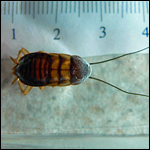 |
Accidentally introduced before 1882, probably from North America. |
Burrowing Cockroach
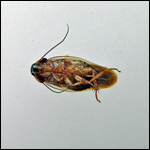 |
Ventral view. |
| |
|
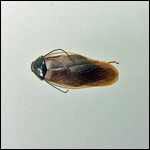 |
Dorsal view. Cockroach is 2 cm long. |
Brown Banded Cockroach
Pacific Beetle Roach Mimic
Unidentified Tenebrionidae Beetle
 |
This beetle is 1.2 cm long. |
| |
|
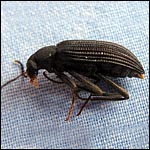 |
|
Blister Beetle
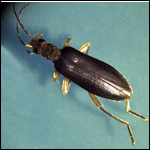 |
Dorsal view. |
| |
|
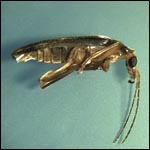 |
Side view. Body length is 10mm. |
False Blister Beetle
 |
Body length 10 mm. |
| |
|
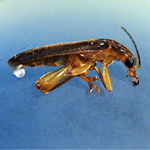 |
|
Eucalyptus Long-horned Beetle
 |
This is a non-native species, established in Hawaii since 1965. |
Small Beetle
 |
This beetle is about 3 mm long. Identification made by Bishop Museum. Introduced species. |
Powder-post Beetle
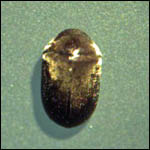 |
Dorsal closed. |
| |
|
 |
Ventral closed. Beetle is 3 mm long. |
| |
|
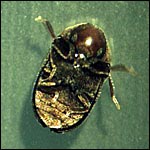 |
Ventral beginning to open. |
| |
|
 |
Ventral ½ open. |
| |
|
 |
Ventral fully opened.
The larva of these beetles eat wood. Specimens are about 2.5 mm long. |
Elaterid Click Beetle
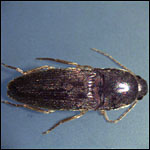 |
|
| |
|
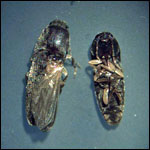 |
Beetle on the left (dorsal view) shows wing on the right half. Beetle is approximately 10 mm long. |
Bark Beetle
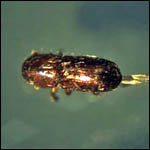 |
Dorsal view. Wing extending from under carapace. |
| |
|
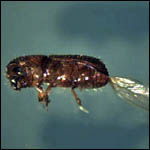 |
Ventral view. Wing extending from under carapace. |
| |
|
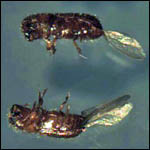 |
Two specimens, both with wings showing. The body of this small beetle is only about 2 mm in length. |
Bark Beetle type 2
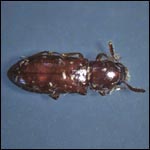 |
Dorsal view. |
| |
|
 |
Ventral view. Body length = 2mm. |
Gonocephalum Darkling Beetle
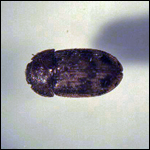 |
Dorsal view. Note bilateral blackish spots. |
| |
|
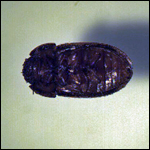 |
Ventral view. Beetle is 4 mm long. |
7 mm Beetle
 |
Side view. |
| |
|
 |
Dorsal view. |
Rove Beetle
 |
Dorsal view. |
| |
|
 |
Side view. |
| |
|
 |
Head close-up.
Beetle length = 1.3 cm. Per Frank Howarth of the Bishop Museum this “is a rove beetle, family Staphylinidae. From the color pattern, size, and what I can see of its form, it is probably Thyreocephalus albertisi (Fauvel, 1877) which was purposefully introduced as a generalist predator of agricultural pests. Rove beetles are mostly predators but also scavenge on rotting animal remains.” |
Tenebrionid Beetle
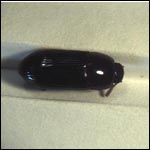 |
Dorsal. |
| |
|
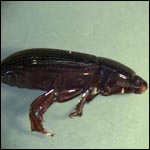 |
Side. |
| |
|
 |
Ventral.
This beetle is 9 mm long. Found in rotting log. Per David Preston of the Bishop Museum “This appears to be the Tenebrionid beetle Uloma bonzica Marseul 1876. They are associated with decaying plant material and the species was first collected by Al Getmann in the mid-eighties from rotting banana stumps.” |
Chinese Rose Beetle
 |
Dorsal view. |
| |
|
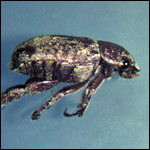 |
Side view. |
| |
|
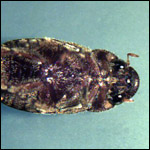 |
Ventral view. |
| |
|
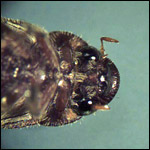 |
Close-up of ventral side of head. This beetle is 1 cm long.
This species was accidentally introduced sometime before 1896. It is native to Japan and Taiwan. |
Lyctid Beetle
Rhipidius Beetle
 |
This beetle is about 2.8 mm long. |
Giant Click Beetle
 |
Dorsal view. |
| |
|
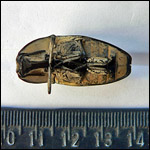 |
Ventral view.
Per Frank Howarth of the Bishop Museum “This is a giant click beetle, accidentally introduced from Central America. The name is Chalcolepidius erythroloma Candeze, 1857, family Elateridae. The larvae are predators and scavengers in rotting wood, and the adults feed on fruits and considered minor pests. The adults make good pets as they are long-lived and have such a spectacular jumping ability.” |
Burrowing Beetle
Black Beetle
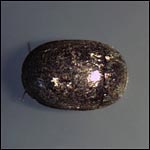 |
This beetle is 6 mm long. ID by David Preston of the Bishop Museum. |
Phenolia Beetle
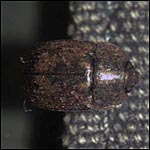 |
|
| |
|
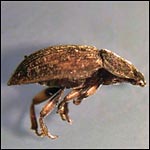 |
|
| |
|
 |
This beetle is 7 mm long.
ID by David Preston of the Bishop Museum. |
Ceresium Long-horned Beetle
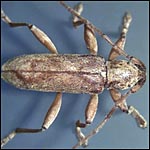 |
Body length is 13 mm. |
Curtomerus Long-horned Beetle
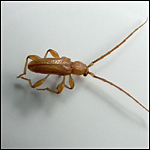 |
This introduced species is common in Hawaii and attacks a wide range of woody tree and shrub species. Body length is 8 mm. Species identification by Frank Howarth of the Bishop Museum. |
Plumeria Borer
 |
Body length is 1.5 cm. Identification by Forest and Kim Starr of the Hawaiian Ecosystems at Risk project (HEAR). |
Monkeypod Roundheaded Borer
 |
Body length is 2.5 cm. |
Cuban Laurel Thrip
 |
This strange little bug is 2 mm long. ID by David Preston of the Bishop Museum. |
Notiobia Ground Beetle
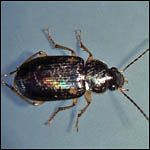 |
Body length of this beetle is 6 mm. ID by David Preston of the Bishop Museum. |
Burrowing Bug
 |
|
| |
|
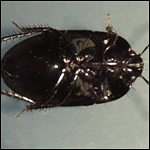 |
This beetle is about 6 mm long. |
Cigarette Beetle
 |
Dorsal view. |
| |
|
 |
Ventral view.
Body length about 2mm. Per Frank Howarth of the Bishop Museum: “This tiny beetle is in the family Anobiidae, which includes many stored product pests and powder-post beetles. Hawaii has many (about 100 species) native wood borers in this group, but your specimen appears to be either the cigarette beetle (Lasioderma serricorne) or the herbaium beetle (Tricorynus herbarium), both of which feed on a variety of dried household products (yes even tobacco!).” |
Mango Flower Beetle
 |
Dorsal view. Length about 1.5 cm. |
| |
|
 |
Side view.
This type of scarab beetle was first found in Hawaii in 1949. |
Kiawe Bruchid (Kiawe Seed Beetle)
 |
This seed beetle (bruchidae) is about 6 mm long and is not native to Hawaii. |
Unknown Seed Beetle
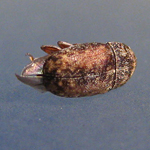 |
Dorsal view. |
| |
|
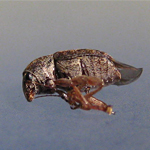 |
Ventral view.
This seed beetle (bruchidae) is about 3 mm long. |
Steel-blue Ladybird Beetle
 |
Dorsal view. |
| |
|
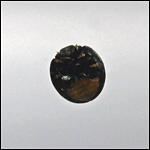 |
Ventral view.
Native to Eastern Australia. Introduced to Western Australia, California, Hawaii and New Zealand as a biological control agent. |
Squash Lady Beetle
 |
This ladybug beetle is one of the few that feed on plants rather than as a predator of insects. It is a minor pest of squash family plants. |
Flour Weevil
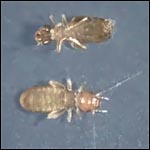 |
Found in a bag of flour. Length about 1 mm. |
Cedar Beetle
 |
A relatively new species on Oahu primarily found in Kaneohe. This is the only known member of the genus Callirhipidae in Hawaii. This identification made by Mikinley Weaver. |
|
|